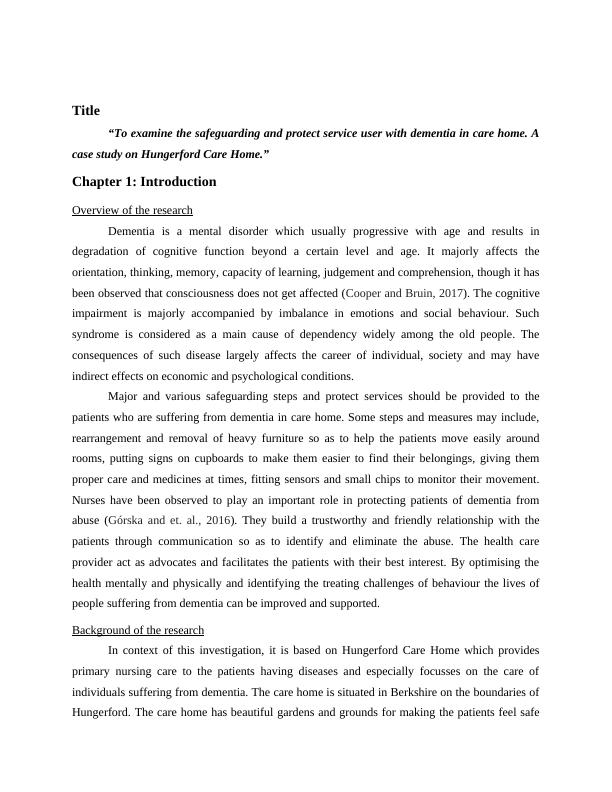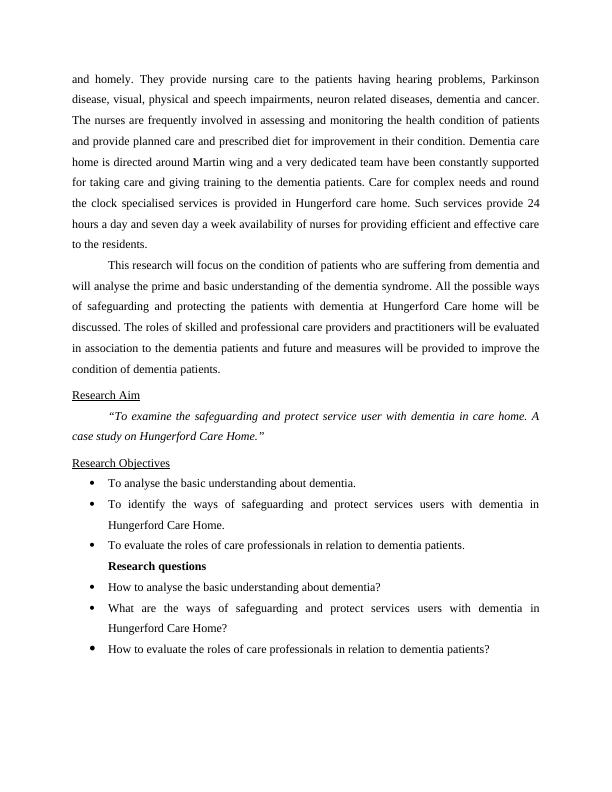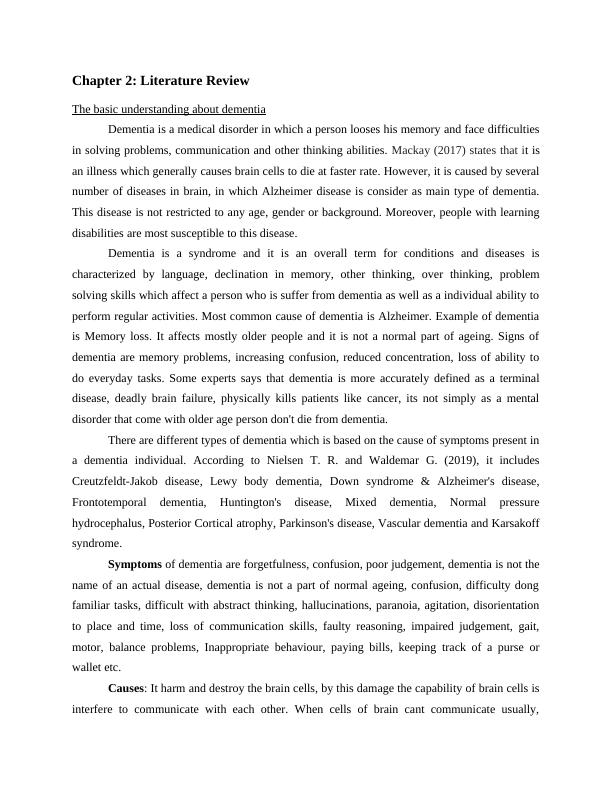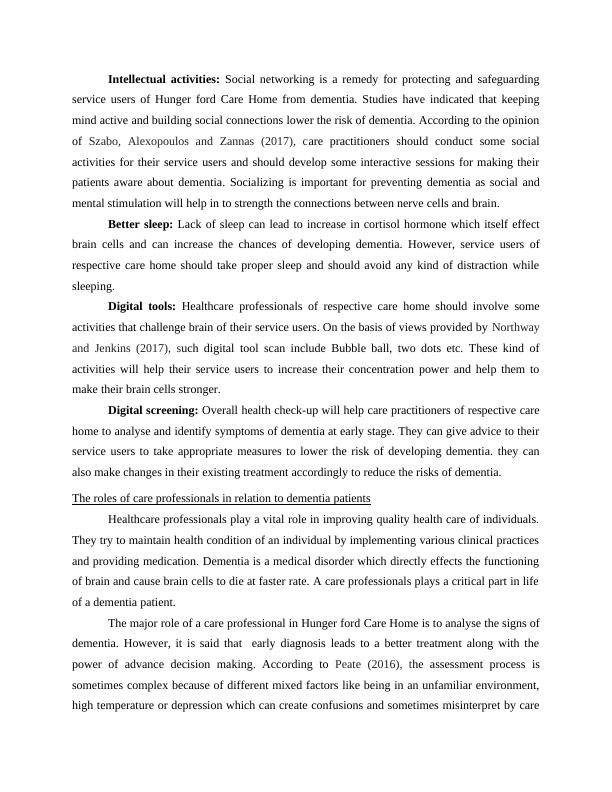Safeguarding and Protecting Service Users with Dementia in Hungerford Care Home
44 Pages8693 Words37 Views
Added on 2023-01-18
About This Document
This research focuses on examining the safeguarding and protection of service users with dementia in Hungerford Care Home. It discusses the basic understanding of dementia, ways to safeguard and protect patients, and the roles of care professionals. The aim is to improve the condition of dementia patients and provide support.
Safeguarding and Protecting Service Users with Dementia in Hungerford Care Home
Added on 2023-01-18
ShareRelated Documents
Improving The Health Of
Others Through Effective
Research
Others Through Effective
Research

Table of Contents
Title..................................................................................................................................................3
Chapter 1: Introduction....................................................................................................................3
Overview of the research........................................................................................................3
Background of the research....................................................................................................3
Research Aim.........................................................................................................................4
Research Objectives...............................................................................................................4
Chapter 2: Literature Review...........................................................................................................5
The basic understanding about dementia...............................................................................5
The ways of safeguarding and protect services users with dementia in Hungerford Care Home
................................................................................................................................................7
The roles of care professionals in relation to dementia patients............................................8
Chapter 3: Research Methodology.................................................................................................11
Types of investigation..........................................................................................................11
Theoretical perspective.........................................................................................................11
Data collection method.........................................................................................................12
Sampling method..................................................................................................................12
Data presentation and analysis.............................................................................................13
Limitations............................................................................................................................14
Overcoming limitations........................................................................................................14
Time frame or work plan......................................................................................................15
Ethical considerations...........................................................................................................17
Chapter 4: Data Analysis...............................................................................................................18
Questionnaire........................................................................................................................18
Data interpretation................................................................................................................22
Chapter 5: Conclusion and Recommendations..............................................................................34
Conclusion............................................................................................................................34
Recommendations................................................................................................................34
Reflective statement.............................................................................................................34
References......................................................................................................................................36
Appendix........................................................................................................................................38
Title..................................................................................................................................................3
Chapter 1: Introduction....................................................................................................................3
Overview of the research........................................................................................................3
Background of the research....................................................................................................3
Research Aim.........................................................................................................................4
Research Objectives...............................................................................................................4
Chapter 2: Literature Review...........................................................................................................5
The basic understanding about dementia...............................................................................5
The ways of safeguarding and protect services users with dementia in Hungerford Care Home
................................................................................................................................................7
The roles of care professionals in relation to dementia patients............................................8
Chapter 3: Research Methodology.................................................................................................11
Types of investigation..........................................................................................................11
Theoretical perspective.........................................................................................................11
Data collection method.........................................................................................................12
Sampling method..................................................................................................................12
Data presentation and analysis.............................................................................................13
Limitations............................................................................................................................14
Overcoming limitations........................................................................................................14
Time frame or work plan......................................................................................................15
Ethical considerations...........................................................................................................17
Chapter 4: Data Analysis...............................................................................................................18
Questionnaire........................................................................................................................18
Data interpretation................................................................................................................22
Chapter 5: Conclusion and Recommendations..............................................................................34
Conclusion............................................................................................................................34
Recommendations................................................................................................................34
Reflective statement.............................................................................................................34
References......................................................................................................................................36
Appendix........................................................................................................................................38

Title
“To examine the safeguarding and protect service user with dementia in care home. A
case study on Hungerford Care Home.”
Chapter 1: Introduction
Overview of the research
Dementia is a mental disorder which usually progressive with age and results in
degradation of cognitive function beyond a certain level and age. It majorly affects the
orientation, thinking, memory, capacity of learning, judgement and comprehension, though it has
been observed that consciousness does not get affected (Cooper and Bruin, 2017). The cognitive
impairment is majorly accompanied by imbalance in emotions and social behaviour. Such
syndrome is considered as a main cause of dependency widely among the old people. The
consequences of such disease largely affects the career of individual, society and may have
indirect effects on economic and psychological conditions.
Major and various safeguarding steps and protect services should be provided to the
patients who are suffering from dementia in care home. Some steps and measures may include,
rearrangement and removal of heavy furniture so as to help the patients move easily around
rooms, putting signs on cupboards to make them easier to find their belongings, giving them
proper care and medicines at times, fitting sensors and small chips to monitor their movement.
Nurses have been observed to play an important role in protecting patients of dementia from
abuse (Górska and et. al., 2016). They build a trustworthy and friendly relationship with the
patients through communication so as to identify and eliminate the abuse. The health care
provider act as advocates and facilitates the patients with their best interest. By optimising the
health mentally and physically and identifying the treating challenges of behaviour the lives of
people suffering from dementia can be improved and supported.
Background of the research
In context of this investigation, it is based on Hungerford Care Home which provides
primary nursing care to the patients having diseases and especially focusses on the care of
individuals suffering from dementia. The care home is situated in Berkshire on the boundaries of
Hungerford. The care home has beautiful gardens and grounds for making the patients feel safe
“To examine the safeguarding and protect service user with dementia in care home. A
case study on Hungerford Care Home.”
Chapter 1: Introduction
Overview of the research
Dementia is a mental disorder which usually progressive with age and results in
degradation of cognitive function beyond a certain level and age. It majorly affects the
orientation, thinking, memory, capacity of learning, judgement and comprehension, though it has
been observed that consciousness does not get affected (Cooper and Bruin, 2017). The cognitive
impairment is majorly accompanied by imbalance in emotions and social behaviour. Such
syndrome is considered as a main cause of dependency widely among the old people. The
consequences of such disease largely affects the career of individual, society and may have
indirect effects on economic and psychological conditions.
Major and various safeguarding steps and protect services should be provided to the
patients who are suffering from dementia in care home. Some steps and measures may include,
rearrangement and removal of heavy furniture so as to help the patients move easily around
rooms, putting signs on cupboards to make them easier to find their belongings, giving them
proper care and medicines at times, fitting sensors and small chips to monitor their movement.
Nurses have been observed to play an important role in protecting patients of dementia from
abuse (Górska and et. al., 2016). They build a trustworthy and friendly relationship with the
patients through communication so as to identify and eliminate the abuse. The health care
provider act as advocates and facilitates the patients with their best interest. By optimising the
health mentally and physically and identifying the treating challenges of behaviour the lives of
people suffering from dementia can be improved and supported.
Background of the research
In context of this investigation, it is based on Hungerford Care Home which provides
primary nursing care to the patients having diseases and especially focusses on the care of
individuals suffering from dementia. The care home is situated in Berkshire on the boundaries of
Hungerford. The care home has beautiful gardens and grounds for making the patients feel safe

and homely. They provide nursing care to the patients having hearing problems, Parkinson
disease, visual, physical and speech impairments, neuron related diseases, dementia and cancer.
The nurses are frequently involved in assessing and monitoring the health condition of patients
and provide planned care and prescribed diet for improvement in their condition. Dementia care
home is directed around Martin wing and a very dedicated team have been constantly supported
for taking care and giving training to the dementia patients. Care for complex needs and round
the clock specialised services is provided in Hungerford care home. Such services provide 24
hours a day and seven day a week availability of nurses for providing efficient and effective care
to the residents.
This research will focus on the condition of patients who are suffering from dementia and
will analyse the prime and basic understanding of the dementia syndrome. All the possible ways
of safeguarding and protecting the patients with dementia at Hungerford Care home will be
discussed. The roles of skilled and professional care providers and practitioners will be evaluated
in association to the dementia patients and future and measures will be provided to improve the
condition of dementia patients.
Research Aim
“To examine the safeguarding and protect service user with dementia in care home. A
case study on Hungerford Care Home.”
Research Objectives
To analyse the basic understanding about dementia.
To identify the ways of safeguarding and protect services users with dementia in
Hungerford Care Home.
To evaluate the roles of care professionals in relation to dementia patients.
Research questions
How to analyse the basic understanding about dementia?
What are the ways of safeguarding and protect services users with dementia in
Hungerford Care Home?
How to evaluate the roles of care professionals in relation to dementia patients?
disease, visual, physical and speech impairments, neuron related diseases, dementia and cancer.
The nurses are frequently involved in assessing and monitoring the health condition of patients
and provide planned care and prescribed diet for improvement in their condition. Dementia care
home is directed around Martin wing and a very dedicated team have been constantly supported
for taking care and giving training to the dementia patients. Care for complex needs and round
the clock specialised services is provided in Hungerford care home. Such services provide 24
hours a day and seven day a week availability of nurses for providing efficient and effective care
to the residents.
This research will focus on the condition of patients who are suffering from dementia and
will analyse the prime and basic understanding of the dementia syndrome. All the possible ways
of safeguarding and protecting the patients with dementia at Hungerford Care home will be
discussed. The roles of skilled and professional care providers and practitioners will be evaluated
in association to the dementia patients and future and measures will be provided to improve the
condition of dementia patients.
Research Aim
“To examine the safeguarding and protect service user with dementia in care home. A
case study on Hungerford Care Home.”
Research Objectives
To analyse the basic understanding about dementia.
To identify the ways of safeguarding and protect services users with dementia in
Hungerford Care Home.
To evaluate the roles of care professionals in relation to dementia patients.
Research questions
How to analyse the basic understanding about dementia?
What are the ways of safeguarding and protect services users with dementia in
Hungerford Care Home?
How to evaluate the roles of care professionals in relation to dementia patients?

Chapter 2: Literature Review
The basic understanding about dementia
Dementia is a medical disorder in which a person looses his memory and face difficulties
in solving problems, communication and other thinking abilities. Mackay (2017) states that it is
an illness which generally causes brain cells to die at faster rate. However, it is caused by several
number of diseases in brain, in which Alzheimer disease is consider as main type of dementia.
This disease is not restricted to any age, gender or background. Moreover, people with learning
disabilities are most susceptible to this disease.
Dementia is a syndrome and it is an overall term for conditions and diseases is
characterized by language, declination in memory, other thinking, over thinking, problem
solving skills which affect a person who is suffer from dementia as well as a individual ability to
perform regular activities. Most common cause of dementia is Alzheimer. Example of dementia
is Memory loss. It affects mostly older people and it is not a normal part of ageing. Signs of
dementia are memory problems, increasing confusion, reduced concentration, loss of ability to
do everyday tasks. Some experts says that dementia is more accurately defined as a terminal
disease, deadly brain failure, physically kills patients like cancer, its not simply as a mental
disorder that come with older age person don't die from dementia.
There are different types of dementia which is based on the cause of symptoms present in
a dementia individual. According to Nielsen T. R. and Waldemar G. (2019), it includes
Creutzfeldt-Jakob disease, Lewy body dementia, Down syndrome & Alzheimer's disease,
Frontotemporal dementia, Huntington's disease, Mixed dementia, Normal pressure
hydrocephalus, Posterior Cortical atrophy, Parkinson's disease, Vascular dementia and Karsakoff
syndrome.
Symptoms of dementia are forgetfulness, confusion, poor judgement, dementia is not the
name of an actual disease, dementia is not a part of normal ageing, confusion, difficulty dong
familiar tasks, difficult with abstract thinking, hallucinations, paranoia, agitation, disorientation
to place and time, loss of communication skills, faulty reasoning, impaired judgement, gait,
motor, balance problems, Inappropriate behaviour, paying bills, keeping track of a purse or
wallet etc.
Causes: It harm and destroy the brain cells, by this damage the capability of brain cells is
interfere to communicate with each other. When cells of brain cant communicate usually,
The basic understanding about dementia
Dementia is a medical disorder in which a person looses his memory and face difficulties
in solving problems, communication and other thinking abilities. Mackay (2017) states that it is
an illness which generally causes brain cells to die at faster rate. However, it is caused by several
number of diseases in brain, in which Alzheimer disease is consider as main type of dementia.
This disease is not restricted to any age, gender or background. Moreover, people with learning
disabilities are most susceptible to this disease.
Dementia is a syndrome and it is an overall term for conditions and diseases is
characterized by language, declination in memory, other thinking, over thinking, problem
solving skills which affect a person who is suffer from dementia as well as a individual ability to
perform regular activities. Most common cause of dementia is Alzheimer. Example of dementia
is Memory loss. It affects mostly older people and it is not a normal part of ageing. Signs of
dementia are memory problems, increasing confusion, reduced concentration, loss of ability to
do everyday tasks. Some experts says that dementia is more accurately defined as a terminal
disease, deadly brain failure, physically kills patients like cancer, its not simply as a mental
disorder that come with older age person don't die from dementia.
There are different types of dementia which is based on the cause of symptoms present in
a dementia individual. According to Nielsen T. R. and Waldemar G. (2019), it includes
Creutzfeldt-Jakob disease, Lewy body dementia, Down syndrome & Alzheimer's disease,
Frontotemporal dementia, Huntington's disease, Mixed dementia, Normal pressure
hydrocephalus, Posterior Cortical atrophy, Parkinson's disease, Vascular dementia and Karsakoff
syndrome.
Symptoms of dementia are forgetfulness, confusion, poor judgement, dementia is not the
name of an actual disease, dementia is not a part of normal ageing, confusion, difficulty dong
familiar tasks, difficult with abstract thinking, hallucinations, paranoia, agitation, disorientation
to place and time, loss of communication skills, faulty reasoning, impaired judgement, gait,
motor, balance problems, Inappropriate behaviour, paying bills, keeping track of a purse or
wallet etc.
Causes: It harm and destroy the brain cells, by this damage the capability of brain cells is
interfere to communicate with each other. When cells of brain cant communicate usually,

behaviour, thinking, feelings can be affected. Usually the Alzheimer is thoughtful common cause
of dementia globally. Chronic subdural haematoma, hydrocephalus, neoplasms, normal pressure
hydrocephalus and it generally considered reversible causes of dementia. It damage
parenchymatous brain disease which causes picks disease, Huntington disease, progressive
supranuclear palsy, as well as it also infect metabolically and causes Wilson disease, hepatic
encephalopathy etc.
Diagnosis: This can be defined as methods and procedures to determine actual cause of
dementia. Alzheimer and other type of dementia which based on a medical analysis, which is
laboratory test like CT scan, MRI and physical examination and identifying changes in thinking,
day by day behaviour and function connected with each type. As mentioned by Wilkins K. M.,
Moore D. and Rohrbaugh R. M. (2019), it is difficult to identify exact type of dementia because
the symptoms and changes in brain of different dementia can overlap. In some cases doctors
diagnose dementia but not a specific type of dementia, it happen maybe essential to see a brain
specialists doctor like neurologist or gero- psychologist.
Treatment: There is no curable treatment presently available for dementia and the new
treatment are being investigated in different clinical trials. According to Bates and McLoughlin
(2019), it includes use of several medications, therapies and lifestyle choices for improving
patients condition. However, it consist Cholinesterase inhibitors (donepezil, rivastigmine &
galantamine), Memantine (Namenda) and Other medications. Some of therapies are effective
including occupational therapy, modifying the environment and simplifying tasks. There are
various lifestyle options that are also helpful such as enhance communication, encourage
exercise, engage in activity, establish a night-time ritual, keep a calendar and plan for the future,
the principals of goals for dementia are as follows-
Optimizing physical health, activity, cognition and well being.
Detecting and treating challenging behavioural and psychological symptoms.
Providing information and long term support to carers.
Risk Factors : The risk factors of dementia are non- compliance, self neglect: meals,
personal hygiene, abuse, exploitation, falls, wandering, Depression, stress, HIV infection, some
immunological disorders, Poor education, low physical activity, Poor nutrition, affect blood
pressure, Blood sugars, Cholesterol, over weight, drug, smoking, alcohol, vascular diseases,
diabetes and heart diseases etc.
of dementia globally. Chronic subdural haematoma, hydrocephalus, neoplasms, normal pressure
hydrocephalus and it generally considered reversible causes of dementia. It damage
parenchymatous brain disease which causes picks disease, Huntington disease, progressive
supranuclear palsy, as well as it also infect metabolically and causes Wilson disease, hepatic
encephalopathy etc.
Diagnosis: This can be defined as methods and procedures to determine actual cause of
dementia. Alzheimer and other type of dementia which based on a medical analysis, which is
laboratory test like CT scan, MRI and physical examination and identifying changes in thinking,
day by day behaviour and function connected with each type. As mentioned by Wilkins K. M.,
Moore D. and Rohrbaugh R. M. (2019), it is difficult to identify exact type of dementia because
the symptoms and changes in brain of different dementia can overlap. In some cases doctors
diagnose dementia but not a specific type of dementia, it happen maybe essential to see a brain
specialists doctor like neurologist or gero- psychologist.
Treatment: There is no curable treatment presently available for dementia and the new
treatment are being investigated in different clinical trials. According to Bates and McLoughlin
(2019), it includes use of several medications, therapies and lifestyle choices for improving
patients condition. However, it consist Cholinesterase inhibitors (donepezil, rivastigmine &
galantamine), Memantine (Namenda) and Other medications. Some of therapies are effective
including occupational therapy, modifying the environment and simplifying tasks. There are
various lifestyle options that are also helpful such as enhance communication, encourage
exercise, engage in activity, establish a night-time ritual, keep a calendar and plan for the future,
the principals of goals for dementia are as follows-
Optimizing physical health, activity, cognition and well being.
Detecting and treating challenging behavioural and psychological symptoms.
Providing information and long term support to carers.
Risk Factors : The risk factors of dementia are non- compliance, self neglect: meals,
personal hygiene, abuse, exploitation, falls, wandering, Depression, stress, HIV infection, some
immunological disorders, Poor education, low physical activity, Poor nutrition, affect blood
pressure, Blood sugars, Cholesterol, over weight, drug, smoking, alcohol, vascular diseases,
diabetes and heart diseases etc.

The ways of safeguarding and protect services users with dementia in Hungerford Care Home
Safeguarding can be described as a phenomena to secure and protect people from any
kind of harm or damage with an appropriate measure. As per views of Nedlund and Taghizadeh
(2016), people with dementia face various problems besides their psychological health problems
like societal issues, neglect, harm etc. It is necessary for care professionals to focus on
safeguarding and protection of patient suffering from dementia for making them well-being as
soon as possible. Meanwhile, it has been analysed that staff of Hungerford care Home should
focus on dementia individuals and ensure their safety while treating them.
There is a need to safeguard and protect service users of Hunger ford Care Home from
dementia as it is a chronic disease and can lead to serious conditions. Service user of respective
care home who have genetic mutations are most likely to develop this disease. However, there
are no specific methods to prevent this disease. Researchers are still investigating to find
appropriate protective measures. As per views given by Unwin, Loskutova and Wood (2019), a
healthy lifestyle is the best option to reduce risk of such chronic disease or to delay them. Health
care practitioners of Hunger ford home care should include some protective measures for
safeguarding their patients from catching dementia. Professionals should first analyse the risk
factors that increase the chances of a service user to develop dementia. Such factors include
untreated depression, isolating from society, loss of hearing ability etc. However, there are
different strategies for protecting and safeguarding individuals from dementia. Such measures
are discussed below.
Diet: A healthy diet could help in to protect service users of respective care home from
getting dementia. Nurses, doctors and other health care practitioners of Hunger ford Care Home
should suggest their patients to avoid diet which is rich in saturated fats, contain high amount of
salt and sugar and diet which are low in fibre cause such type of food can increase chance of
high blood pressure and high cholesterol (Barnett, 2019). High cholesterol will lead to obesity
and cause stress to individual which eventually cause them dementia.
Physical exercise: Regular physical exercises can be consider as a good strategy for
lowering the chance of dementia. Hence, service users of respective home care should do
physical exercise at regular basis because it will directly benefit brain cells of individuals by
increasing flow of oxygen and blood.
Safeguarding can be described as a phenomena to secure and protect people from any
kind of harm or damage with an appropriate measure. As per views of Nedlund and Taghizadeh
(2016), people with dementia face various problems besides their psychological health problems
like societal issues, neglect, harm etc. It is necessary for care professionals to focus on
safeguarding and protection of patient suffering from dementia for making them well-being as
soon as possible. Meanwhile, it has been analysed that staff of Hungerford care Home should
focus on dementia individuals and ensure their safety while treating them.
There is a need to safeguard and protect service users of Hunger ford Care Home from
dementia as it is a chronic disease and can lead to serious conditions. Service user of respective
care home who have genetic mutations are most likely to develop this disease. However, there
are no specific methods to prevent this disease. Researchers are still investigating to find
appropriate protective measures. As per views given by Unwin, Loskutova and Wood (2019), a
healthy lifestyle is the best option to reduce risk of such chronic disease or to delay them. Health
care practitioners of Hunger ford home care should include some protective measures for
safeguarding their patients from catching dementia. Professionals should first analyse the risk
factors that increase the chances of a service user to develop dementia. Such factors include
untreated depression, isolating from society, loss of hearing ability etc. However, there are
different strategies for protecting and safeguarding individuals from dementia. Such measures
are discussed below.
Diet: A healthy diet could help in to protect service users of respective care home from
getting dementia. Nurses, doctors and other health care practitioners of Hunger ford Care Home
should suggest their patients to avoid diet which is rich in saturated fats, contain high amount of
salt and sugar and diet which are low in fibre cause such type of food can increase chance of
high blood pressure and high cholesterol (Barnett, 2019). High cholesterol will lead to obesity
and cause stress to individual which eventually cause them dementia.
Physical exercise: Regular physical exercises can be consider as a good strategy for
lowering the chance of dementia. Hence, service users of respective home care should do
physical exercise at regular basis because it will directly benefit brain cells of individuals by
increasing flow of oxygen and blood.

Intellectual activities: Social networking is a remedy for protecting and safeguarding
service users of Hunger ford Care Home from dementia. Studies have indicated that keeping
mind active and building social connections lower the risk of dementia. According to the opinion
of Szabo, Alexopoulos and Zannas (2017), care practitioners should conduct some social
activities for their service users and should develop some interactive sessions for making their
patients aware about dementia. Socializing is important for preventing dementia as social and
mental stimulation will help in to strength the connections between nerve cells and brain.
Better sleep: Lack of sleep can lead to increase in cortisol hormone which itself effect
brain cells and can increase the chances of developing dementia. However, service users of
respective care home should take proper sleep and should avoid any kind of distraction while
sleeping.
Digital tools: Healthcare professionals of respective care home should involve some
activities that challenge brain of their service users. On the basis of views provided by Northway
and Jenkins (2017), such digital tool scan include Bubble ball, two dots etc. These kind of
activities will help their service users to increase their concentration power and help them to
make their brain cells stronger.
Digital screening: Overall health check-up will help care practitioners of respective care
home to analyse and identify symptoms of dementia at early stage. They can give advice to their
service users to take appropriate measures to lower the risk of developing dementia. they can
also make changes in their existing treatment accordingly to reduce the risks of dementia.
The roles of care professionals in relation to dementia patients
Healthcare professionals play a vital role in improving quality health care of individuals.
They try to maintain health condition of an individual by implementing various clinical practices
and providing medication. Dementia is a medical disorder which directly effects the functioning
of brain and cause brain cells to die at faster rate. A care professionals plays a critical part in life
of a dementia patient.
The major role of a care professional in Hunger ford Care Home is to analyse the signs of
dementia. However, it is said that early diagnosis leads to a better treatment along with the
power of advance decision making. According to Peate (2016), the assessment process is
sometimes complex because of different mixed factors like being in an unfamiliar environment,
high temperature or depression which can create confusions and sometimes misinterpret by care
service users of Hunger ford Care Home from dementia. Studies have indicated that keeping
mind active and building social connections lower the risk of dementia. According to the opinion
of Szabo, Alexopoulos and Zannas (2017), care practitioners should conduct some social
activities for their service users and should develop some interactive sessions for making their
patients aware about dementia. Socializing is important for preventing dementia as social and
mental stimulation will help in to strength the connections between nerve cells and brain.
Better sleep: Lack of sleep can lead to increase in cortisol hormone which itself effect
brain cells and can increase the chances of developing dementia. However, service users of
respective care home should take proper sleep and should avoid any kind of distraction while
sleeping.
Digital tools: Healthcare professionals of respective care home should involve some
activities that challenge brain of their service users. On the basis of views provided by Northway
and Jenkins (2017), such digital tool scan include Bubble ball, two dots etc. These kind of
activities will help their service users to increase their concentration power and help them to
make their brain cells stronger.
Digital screening: Overall health check-up will help care practitioners of respective care
home to analyse and identify symptoms of dementia at early stage. They can give advice to their
service users to take appropriate measures to lower the risk of developing dementia. they can
also make changes in their existing treatment accordingly to reduce the risks of dementia.
The roles of care professionals in relation to dementia patients
Healthcare professionals play a vital role in improving quality health care of individuals.
They try to maintain health condition of an individual by implementing various clinical practices
and providing medication. Dementia is a medical disorder which directly effects the functioning
of brain and cause brain cells to die at faster rate. A care professionals plays a critical part in life
of a dementia patient.
The major role of a care professional in Hunger ford Care Home is to analyse the signs of
dementia. However, it is said that early diagnosis leads to a better treatment along with the
power of advance decision making. According to Peate (2016), the assessment process is
sometimes complex because of different mixed factors like being in an unfamiliar environment,
high temperature or depression which can create confusions and sometimes misinterpret by care

End of preview
Want to access all the pages? Upload your documents or become a member.
Related Documents
To Examine the Safeguarding and Protect Service User with Dementia in Care Homelg...
|13
|645
|64
Safeguarding Service Users with Dementia in Care Homelg...
|35
|9510
|69
HEALTH AND SOCIAL CARE MANAGEMENT For Adults with Dementialg...
|28
|6766
|20
Research Proposallg...
|5
|619
|50
Experience of Nurses and Care Workers with Challenging Behaviour of Dementia Patientslg...
|53
|23201
|164
Lewy Body Dementia - Researchlg...
|30
|11265
|381
